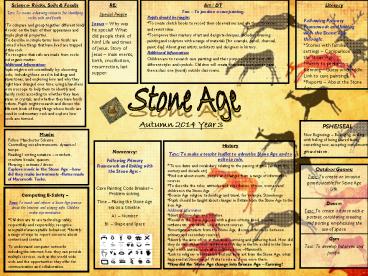Stone Age - PowerPoint PPT Presentation
Title:
Stone Age
Description:
Following Primary Framework and linking with the Stone Age through: ... Tasc: To create an invasion game suitable for Stone Age Life. Computing E-Safety – PowerPoint PPT presentation
Number of Views:87
Avg rating:3.0/5.0
Title: Stone Age
1
Literacy Following Primary Framework and linking
with the Stone Age through Stories with
familiar settings Comparison with the Stone
Age. Poetry to perform Kenning Guess who
riddle. Link to cave paintings. Reports About
the Stone Age.
RE Special People Jesus Why was he special?
What did people think of him? Life and times of
Jesus. Story of Jesus main events, birth,
crucifixition, resurrection, last supper.
Art / DT Tasc To produce a cave
painting. Pupils should be taught To create
sketch books to record their observations and use
them to review and revisit ideas. To improve
their mastery of art and design techniques,
including drawing, painting and sculpture with a
range of materials for example, pencil,
charcoal, paint, clay About great artists,
architects and designers in history. Additional
Information Children are to research cave
paintings and their purpose, experiment
with different styles and symbols. Children will
create their own cave painting and then a class
one (mural) outside classrooms.
Science- Rocks, Soils Fossils Tasc To create a
learning resource for identifying rocks, soils
and fossils. To compare and group together
different kinds of rocks on the basis of their
appearance and simple physical properties. To
describe in simple terms how fossils are formed
when things that have lived are trapped within
rock To recognise that soils are made from rocks
and organic matter. Additional Information Pupils
might work scientifically by observing rocks,
including those used in buildings and
gravestones, and exploring how and why they might
have changed over time using a hand lens or
microscope to help them to identify and classify
rocks according to whether they have grains or
crystals, and whether they have fossils in them.
Pupils might research and discuss the different
kinds of living things whose fossils are found in
sedimentary rock and explore how fossils are
formed.
Stone Age
Autumn 2014 Year 3
PSHE/SEAL New Beginnings Belonging, dealings
with feeling of being scared facing something
new, accepting compliments, gift and talents.
Music Follow Manchester Scheme Controlling
voice/instruments- dynamics/ tempo Reading /
writing notation crotchets, crochets breaks,
quavers. Phrasing ostinato / drone Explore
music in the Stone Age how did they make
instruments flutes made of Mammoth Tusks.
History Tasc To make a tourist leaflet to
advertise Stone Age and to write in role. To use
dates and vocabulary relating to the passing of
time (ancient, BC, century and decade etc) Find
out about events, people and changes from a range
of information sources To describe the roles,
attitudes and experiences of men, women and
children in the Stone Age. Bronze Age religion,
technology and travel, for example,
Stonehenge Pupils should be taught about changes
in Britain from the Stone Age to the Iron Age.
Additional Information Identity Stone Age on a
timeline. Research the Stone Age era with a
given criteria food, weather, settlements, way
of life. Use different sources. Investigate
artefacts from the Stone Age, discuss differences
between primary and secondary sources. Identify
the aims of live at that time surviving and
gathering food. How did they do this? What tools
did they use? A day in the life a child in the
Stone Age/ which animlas were alive in those
times Mammoth. Link to religion- what can we
find out from art from the Stone Age, what
happened at Stonehenge? Write in role as if you
were there. How did the Stone Age change into
Bronze Age Farming!
Numeracy Following Primary Framework and linking
with the Stone Age - Cave Painting Code
Breaker Problem solving. Time Placing the
Stone Age era on a timeline. A1 Number B1
Shape and Space
Outdoor Games Tasc To create an invasion game suitable for Stone Age Life.
Dance Tasc To create a dance with a partner, considering meeting and parting, emphasising the use of space.
Gym Tasc To develop balances and jumps.
Computing E-Safety Tasc To teach and inform a
Stone Age person about the Internet and staying
safe. Children make a presentation. Children
are to use technology safely, respectfully and
responsibly recognise acceptable/unacceptable
behaviour Identify a range of ways to report
concerns about content and contact. To understand
computer networks including the internet how
they can provide multiple services, such as the
world wide web and the opportunities they offer
for communication and collaboration.































![Download ⚡[EBOOK]⚡ Frédéric Chaubin. Stone Age (PHOTO) (English, French and German Edition) PowerPoint PPT Presentation](https://s3.amazonaws.com/images.powershow.com/10069443.th0.jpg?_=20240702123)